Ducati Monster 2021 First Ride Review
By Wayfarer |
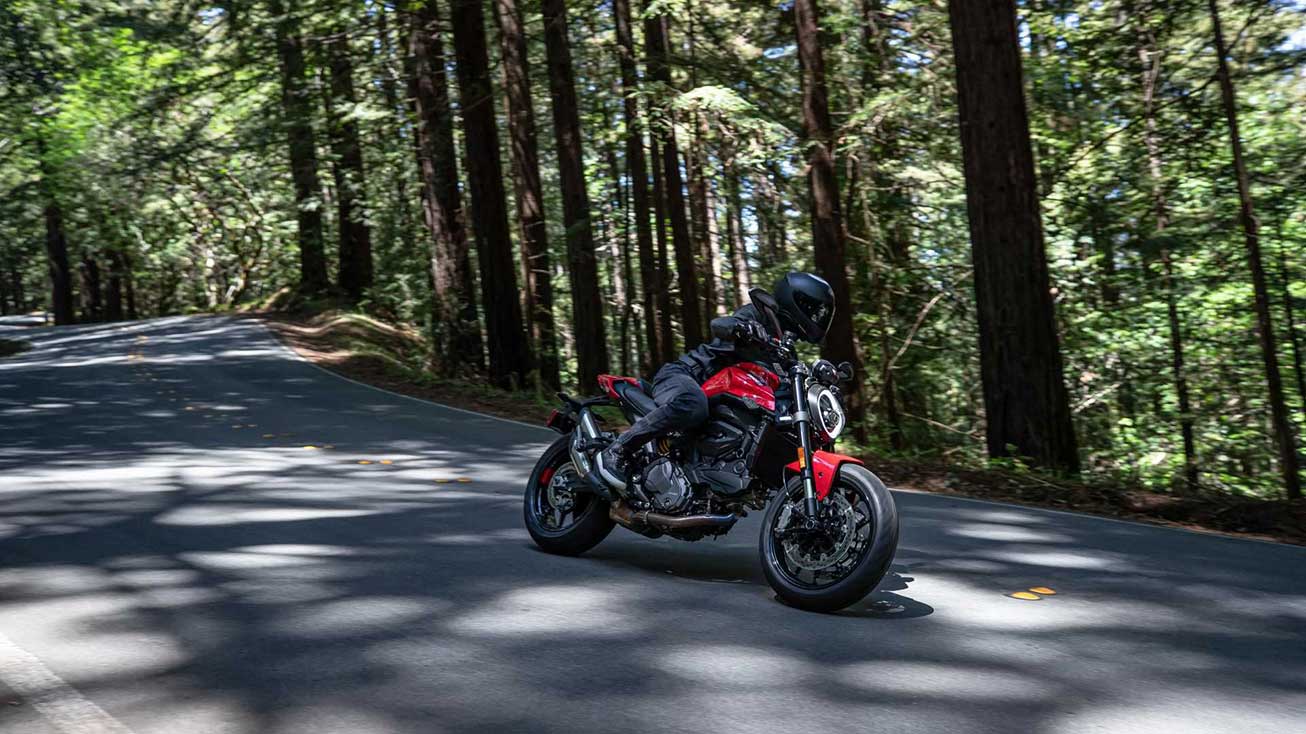 by Dustin Wheelen from https://www.rideapart.com
Take the edge off.
In 1992, Ducati designer Miguel Galluzzi shoehorned a 900SS engine into an 888 superbike frame. He then bolted on a 750 Supersport fork and the Ducati Monster was born. Galluzzi’s Frankenstein experiment was well-loved though, driving sales at the Bologna brand for years. The parts bin special saved Ducati, in fact, and the Monster has remained in Ducati’s stable ever since.
That hasn’t stopped the Monster from evolving through the years, though. Ducati frequently tweaked the ingredients, but the recipe remained the same: one part air-cooled L-twin, one part trellis frame. However, technology and design move on, and the model has changed with the times. By 2015, all Monster engines switched to liquid-cooling, and the latest iteration finally sheds its trellis frame—and the weight that comes with it.
That prompted traditionalists and ardent Ducatisi to click their tongues, lamenting over Ducati’s heresy. To many fans, the trellis frame was the Monster’s pièce de résistance. The quality that separated the muscular streetfighter from its “soulless” competitors. The trellis frame was the Monster’s greatest strength, but it was also its greatest weakness, imprisoning the naked bike to a bygone era as its counterparts forged ahead.
That’s no longer the case in 2021. Sure, the Monster is still “borrowing” from its counterparts by plucking the 937cc L-twin from the Supersport 950 and wedging it into a Panigale V4-inspried monocoque aluminum frame. Even the model’s 4.3-inch TFT dash sports a Panigale V4-derived interface. Despite those old habits, the question remains: is it still a Monster without the trellis frame? Did it trade in its panache for pastiche? Did it lose its character, its “soul”?
These questions loomed large when Ducati invited us to San Francisco, California, to ride the 2021 Monster. After spending a full day in the saddle of the new bike, it was clear that this is a very different beast.
Engine:
To meet Euro5 emissions standards, Ducati ditched the Monster’s 821cc Testastretta engine in favor of the proven mill found in Ducati’s Hypermotard 950 and Supersport 950. The 11-degree Testastretta configuration carries over, but Ducati bumps the capacity to 937cc for good reasons. That’s 111 good reasons, in the form of horsepower. Ducati couples that with a generous 69 lb-ft helping of torque. More than enough bark and bite for the naysayers.
The powerplant may tout a higher volume than the outgoing unit, but it also shaved off 5.7 pounds in the process. The new clutch drops three pounds alone while the cylinder heads and clutch cover account for two additional pounds of weight loss. The updated gear drum, alternator cover, and pistons and rods pitch in too, saving precious grams.
Ducati’s versatile Testastretta platform isn’t just performance-oriented, however, it’s surprisingly practical as well. New Monster owners can enjoy a whole lot of riding between the 9,000-mile oil services and 18,000-mile valve services. The revised hydraulic clutch also reduces resistance at the lever by 20 percent and the up/down quickshifter nearly eliminates clutch use altogether.
That’s the same Ducati Quick Shift (DQS) Evo 2 found on the $24,095 Multistrada V4 S, and the IMU-dependent system works just as well on this $11,895 naked bike. In fact, the DQS equipped on the Monster produces an even more satisfying exhaust note upon downshifting. Modern emissions regulations have taken the voice box of many a motorcycle, but Ducati’s auto-blipper gives the Monster a formidable growl.
Upshifts were just as visceral, but for an entirely different reason. Though the bike’s fueling was pretty fluttery below 3,500 rpm, the Monster really bared its teeth between 4,000-7,000 rpm. A series of clutchless upshifts only amplified the effect. The power delivery never bordered on frightening, though. Of course, if 111 ponies are too much pep for your step, Ducati’s three ride modes help tame the Monster’s inner animal.
Those looking for an easy-breezy experience can switch to Urban mode, which restricts output to 75 horsepower. For highway blasts, Touring mode maintains peak horsepower but prioritizes smooth acceleration. Predictively, Sport mode is the least restrictive, but that doesn’t make it less manageable than its counterparts. After a short squirt through the hilly San Francisco streets, I kept the engine in Sport mode for the rest of the day. Even in the tight and twisty confines of Route 35, the lively engine response never felt overwhelming. Thanks, primarily, to the new superbike-derived frame.
Chassis:
While the engine’s before/after results were truly impressive, Ducati engineers went to greater lengths to reduce the chassis’ mass. Compared to the 821’s trellis front frame, the new monocoque saves 9.9 pounds. The fiberglass-reinforced polymer subframe comes in 4.2 pounds underweight while the swingarm and wheels reduce unsprung weight by 7.2 pounds. Ducati’s diet plan worked wonders for the Monster, converting the heavy brute to a lithe apex predator.
That new, low 414-pound wet weight is noticeable right off the kickstand. Fleet-footed yet planted, the Monster takes advantage of that newfound agility in the turns. Initial tip-in is effortless and side-to-side transitions are predictable and smooth. That sharp-handling quality should redeem the Monster in the eyes of Ducati fans, but focused track riders may discount the sporty naked bike for lacking fully adjustable suspension.
Speaking of, in stock form, the 43mm USD front end and preload-adjustable lean on the stiffer side. At least they did under my 160-pound frame. Heavier riders may benefit more from the spring rate, but the suspension only borders on harsh at the least favorable time—at lean. Northern California’s Skyline Boulevard is a relatively well-maintained mountain road, but a few inconveniently placed potholes unsettled the Monster’s sure-footed stance.
Of course, no suspension operates optimally when leaned over, but the sharp hit doesn’t just stop at the springs. That new, responsive aluminum chassis also relayed those shockwaves up through to the rider. Luckily, the Monster was quick to regain its composure and continued attacking corners. Aside from those rare moments of instability, though, the Monster handled everything the city and the canyons could throw at it.
Unlike the suspension, the braking system’s pedigree was never in question. Brembo M4.32 monoblock calipers bite down on twin 320mm discs up front and a dual-piston binder mates to a 245mm disc out back. A radial master cylinder is the last piece of the puzzle, and it delivers incredible feedback at the lever. Whether navigating downtown traffic or approaching a decreasing radius hairpin, the braking performance was confidence-inspiring.
Of course, losing 40 pounds would help any motorcycle shed speed quickly, but that weight loss also informed the motorcycle’s design and user experience.
Ergonomics:
Ducati went to great lengths to reduce the new Monster’s proportions. Along with losing weight, the bike also lost the visual heaviness of its trellis frame and oversized gas tank. The new dimensions deliver a compact yet comfortable riding position that’s neither too aggressive nor lax.
A 58-inch wheelbase certainly helps with handling but it also relaxes the rider triangle. Ducati pairs that compact cockpit with a handlebar that’s 2.6 inches closer to the rider and footpegs positioned .5 inches lower and 1.5 inches rearward. At 32.3 inches, the standard seat height is easy to flat foot, but those with shorter inseams can also purchase a low seat and a lowering kit that drops the perch to 30.5 inches high.
Before jumping for the accessories catalog, I recommend throwing a leg over the new Monster. Ducati narrowed the seat-to-tank area to maximize stand over comfort, and the strategy worked. However, the narrow stand-over position also introduced my knees to a few Testastretta engine cases. On the left side of the bike, the radiator and water pump plumbing can get in the way and the clutch cover is just as obtrusive on the right. It wasn’t too bothersome throughout the day, but it’s definitely worth mentioning.
Aside from those slight discomforts, the new seating position encourages day-long riding. Stretch to the bars is minimal and the narrow cutouts promote clenching the tank with one’s knees. In turn, the ergonomic position alleviated pressure on my wrists and results in a very pleasant riding experience. In the city, however, the stop-and-go traffic definitely introduced wrist fatigue.
Urban riding also revealed that the Monster had the same heat management issues as its predecessors. At speed, the Monster didn’t throw off an irksome amount of warmth, but from light to light, the new naked bike simply radiated heat. Even in Urban mode, the engine reached high temps. If you’re considering a 2021 Monster, you should also consider living near a highway. The Monster is more play than business and excessive urban environs will get it hot under the collar.
The only other tick against the new-fangled Ducati is that L-Twin’s vibration. Of course, that rumble sets the Monster apart from its parallel-twin rivals, but by 7,000 rpm, the high-frequency buzz prompted early upshifts. The vibration is nearly imperceptible at the pegs, marginally more noticeable at the bars, but it’s most present at the seat cowl. With my tailbone pressed against the seat stop, I could tell when the tachometer was approaching that 7,000-rpm threshold just by the vibration.
Electronics:
I can’t wrap up this review without calling attention to the Monster’s impressive electronic suite. With three levels of ABS cornering, eight levels of cornering traction control, four-leveled wheelie control, and launch control, Ducati’s system presents an absurd degree of customization. With that said, I’m the type of person that likes to set it and forget it. Many customers will love the number of doodads on the middleweight roadster, but others will find what they like and stick to it.
Regardless of which camp you’re in, the rider aids and engine performance options make the Monster a more malleable platform. On the other hand, flipping through the numerous menus would be easier if Ducati consolidated the split function navigation and enter buttons on the left switchgear. Also, many electronic interfaces automatically navigate back to the previous menu when the rider confirms a selection. With the Monster’s system, the user has to manually backtrack.
Even with those minor gripes, the electronics suite is clear and easy to use. That should broaden the model’s appeal as it approaches three decades on the market. It’s clear that Ducati wants to angle the new Monster toward a younger demographic, and it believes robust safety aids and rider modes help those efforts.
While all the ride modes are tractable for seasoned vets, I’d hesitate to put the Monster in a brand-new rider’s hands. The entry-level naked bike may be the perfect first Ducati, but that doesn’t make it the perfect first bike. This new Monster is well-mannered, but it hasn’t lost its claws. Rider aids should be there as a safety net, not training wheels, but the Monster would be great bike for intermediate riders to grow into over the years.
Conclusion:
So, did the Monster lose its “soul” when it lost its trellis frame? No, it didn’t. At the same time, it isn’t the same Monster. It’s more youthful. Yes, the trellis frame’s absence is felt. Without its signature visual cue, the Monster doesn’t stand out from the crowd as much, but it does stand toe-to-toe with the KTM 890 Duke, Triumph Street Triple, and Yamaha MT-09. No, the Monster didn’t lose its “soul” it just developed a playful spirit.
If you’re someone that likes the “oohs and aahs” that come with a Ducati, the new Monster may not be for you. If you want a motorcycle that’s light on its feet, attacks the corners, and just happens to be red, the new Duc should be your cup of tea. The 2021 Monster will suit a wide swath of riders just like it did 28 years ago. Those customers may be different today than they were in 1993 and the Monster will only continue to evolve (without the trellis frame) for the next three decades.
by Dustin Wheelen from https://www.rideapart.com
Take the edge off.
In 1992, Ducati designer Miguel Galluzzi shoehorned a 900SS engine into an 888 superbike frame. He then bolted on a 750 Supersport fork and the Ducati Monster was born. Galluzzi’s Frankenstein experiment was well-loved though, driving sales at the Bologna brand for years. The parts bin special saved Ducati, in fact, and the Monster has remained in Ducati’s stable ever since.
That hasn’t stopped the Monster from evolving through the years, though. Ducati frequently tweaked the ingredients, but the recipe remained the same: one part air-cooled L-twin, one part trellis frame. However, technology and design move on, and the model has changed with the times. By 2015, all Monster engines switched to liquid-cooling, and the latest iteration finally sheds its trellis frame—and the weight that comes with it.
That prompted traditionalists and ardent Ducatisi to click their tongues, lamenting over Ducati’s heresy. To many fans, the trellis frame was the Monster’s pièce de résistance. The quality that separated the muscular streetfighter from its “soulless” competitors. The trellis frame was the Monster’s greatest strength, but it was also its greatest weakness, imprisoning the naked bike to a bygone era as its counterparts forged ahead.
That’s no longer the case in 2021. Sure, the Monster is still “borrowing” from its counterparts by plucking the 937cc L-twin from the Supersport 950 and wedging it into a Panigale V4-inspried monocoque aluminum frame. Even the model’s 4.3-inch TFT dash sports a Panigale V4-derived interface. Despite those old habits, the question remains: is it still a Monster without the trellis frame? Did it trade in its panache for pastiche? Did it lose its character, its “soul”?
These questions loomed large when Ducati invited us to San Francisco, California, to ride the 2021 Monster. After spending a full day in the saddle of the new bike, it was clear that this is a very different beast.
Engine:
To meet Euro5 emissions standards, Ducati ditched the Monster’s 821cc Testastretta engine in favor of the proven mill found in Ducati’s Hypermotard 950 and Supersport 950. The 11-degree Testastretta configuration carries over, but Ducati bumps the capacity to 937cc for good reasons. That’s 111 good reasons, in the form of horsepower. Ducati couples that with a generous 69 lb-ft helping of torque. More than enough bark and bite for the naysayers.
The powerplant may tout a higher volume than the outgoing unit, but it also shaved off 5.7 pounds in the process. The new clutch drops three pounds alone while the cylinder heads and clutch cover account for two additional pounds of weight loss. The updated gear drum, alternator cover, and pistons and rods pitch in too, saving precious grams.
Ducati’s versatile Testastretta platform isn’t just performance-oriented, however, it’s surprisingly practical as well. New Monster owners can enjoy a whole lot of riding between the 9,000-mile oil services and 18,000-mile valve services. The revised hydraulic clutch also reduces resistance at the lever by 20 percent and the up/down quickshifter nearly eliminates clutch use altogether.
That’s the same Ducati Quick Shift (DQS) Evo 2 found on the $24,095 Multistrada V4 S, and the IMU-dependent system works just as well on this $11,895 naked bike. In fact, the DQS equipped on the Monster produces an even more satisfying exhaust note upon downshifting. Modern emissions regulations have taken the voice box of many a motorcycle, but Ducati’s auto-blipper gives the Monster a formidable growl.
Upshifts were just as visceral, but for an entirely different reason. Though the bike’s fueling was pretty fluttery below 3,500 rpm, the Monster really bared its teeth between 4,000-7,000 rpm. A series of clutchless upshifts only amplified the effect. The power delivery never bordered on frightening, though. Of course, if 111 ponies are too much pep for your step, Ducati’s three ride modes help tame the Monster’s inner animal.
Those looking for an easy-breezy experience can switch to Urban mode, which restricts output to 75 horsepower. For highway blasts, Touring mode maintains peak horsepower but prioritizes smooth acceleration. Predictively, Sport mode is the least restrictive, but that doesn’t make it less manageable than its counterparts. After a short squirt through the hilly San Francisco streets, I kept the engine in Sport mode for the rest of the day. Even in the tight and twisty confines of Route 35, the lively engine response never felt overwhelming. Thanks, primarily, to the new superbike-derived frame.
Chassis:
While the engine’s before/after results were truly impressive, Ducati engineers went to greater lengths to reduce the chassis’ mass. Compared to the 821’s trellis front frame, the new monocoque saves 9.9 pounds. The fiberglass-reinforced polymer subframe comes in 4.2 pounds underweight while the swingarm and wheels reduce unsprung weight by 7.2 pounds. Ducati’s diet plan worked wonders for the Monster, converting the heavy brute to a lithe apex predator.
That new, low 414-pound wet weight is noticeable right off the kickstand. Fleet-footed yet planted, the Monster takes advantage of that newfound agility in the turns. Initial tip-in is effortless and side-to-side transitions are predictable and smooth. That sharp-handling quality should redeem the Monster in the eyes of Ducati fans, but focused track riders may discount the sporty naked bike for lacking fully adjustable suspension.
Speaking of, in stock form, the 43mm USD front end and preload-adjustable lean on the stiffer side. At least they did under my 160-pound frame. Heavier riders may benefit more from the spring rate, but the suspension only borders on harsh at the least favorable time—at lean. Northern California’s Skyline Boulevard is a relatively well-maintained mountain road, but a few inconveniently placed potholes unsettled the Monster’s sure-footed stance.
Of course, no suspension operates optimally when leaned over, but the sharp hit doesn’t just stop at the springs. That new, responsive aluminum chassis also relayed those shockwaves up through to the rider. Luckily, the Monster was quick to regain its composure and continued attacking corners. Aside from those rare moments of instability, though, the Monster handled everything the city and the canyons could throw at it.
Unlike the suspension, the braking system’s pedigree was never in question. Brembo M4.32 monoblock calipers bite down on twin 320mm discs up front and a dual-piston binder mates to a 245mm disc out back. A radial master cylinder is the last piece of the puzzle, and it delivers incredible feedback at the lever. Whether navigating downtown traffic or approaching a decreasing radius hairpin, the braking performance was confidence-inspiring.
Of course, losing 40 pounds would help any motorcycle shed speed quickly, but that weight loss also informed the motorcycle’s design and user experience.
Ergonomics:
Ducati went to great lengths to reduce the new Monster’s proportions. Along with losing weight, the bike also lost the visual heaviness of its trellis frame and oversized gas tank. The new dimensions deliver a compact yet comfortable riding position that’s neither too aggressive nor lax.
A 58-inch wheelbase certainly helps with handling but it also relaxes the rider triangle. Ducati pairs that compact cockpit with a handlebar that’s 2.6 inches closer to the rider and footpegs positioned .5 inches lower and 1.5 inches rearward. At 32.3 inches, the standard seat height is easy to flat foot, but those with shorter inseams can also purchase a low seat and a lowering kit that drops the perch to 30.5 inches high.
Before jumping for the accessories catalog, I recommend throwing a leg over the new Monster. Ducati narrowed the seat-to-tank area to maximize stand over comfort, and the strategy worked. However, the narrow stand-over position also introduced my knees to a few Testastretta engine cases. On the left side of the bike, the radiator and water pump plumbing can get in the way and the clutch cover is just as obtrusive on the right. It wasn’t too bothersome throughout the day, but it’s definitely worth mentioning.
Aside from those slight discomforts, the new seating position encourages day-long riding. Stretch to the bars is minimal and the narrow cutouts promote clenching the tank with one’s knees. In turn, the ergonomic position alleviated pressure on my wrists and results in a very pleasant riding experience. In the city, however, the stop-and-go traffic definitely introduced wrist fatigue.
Urban riding also revealed that the Monster had the same heat management issues as its predecessors. At speed, the Monster didn’t throw off an irksome amount of warmth, but from light to light, the new naked bike simply radiated heat. Even in Urban mode, the engine reached high temps. If you’re considering a 2021 Monster, you should also consider living near a highway. The Monster is more play than business and excessive urban environs will get it hot under the collar.
The only other tick against the new-fangled Ducati is that L-Twin’s vibration. Of course, that rumble sets the Monster apart from its parallel-twin rivals, but by 7,000 rpm, the high-frequency buzz prompted early upshifts. The vibration is nearly imperceptible at the pegs, marginally more noticeable at the bars, but it’s most present at the seat cowl. With my tailbone pressed against the seat stop, I could tell when the tachometer was approaching that 7,000-rpm threshold just by the vibration.
Electronics:
I can’t wrap up this review without calling attention to the Monster’s impressive electronic suite. With three levels of ABS cornering, eight levels of cornering traction control, four-leveled wheelie control, and launch control, Ducati’s system presents an absurd degree of customization. With that said, I’m the type of person that likes to set it and forget it. Many customers will love the number of doodads on the middleweight roadster, but others will find what they like and stick to it.
Regardless of which camp you’re in, the rider aids and engine performance options make the Monster a more malleable platform. On the other hand, flipping through the numerous menus would be easier if Ducati consolidated the split function navigation and enter buttons on the left switchgear. Also, many electronic interfaces automatically navigate back to the previous menu when the rider confirms a selection. With the Monster’s system, the user has to manually backtrack.
Even with those minor gripes, the electronics suite is clear and easy to use. That should broaden the model’s appeal as it approaches three decades on the market. It’s clear that Ducati wants to angle the new Monster toward a younger demographic, and it believes robust safety aids and rider modes help those efforts.
While all the ride modes are tractable for seasoned vets, I’d hesitate to put the Monster in a brand-new rider’s hands. The entry-level naked bike may be the perfect first Ducati, but that doesn’t make it the perfect first bike. This new Monster is well-mannered, but it hasn’t lost its claws. Rider aids should be there as a safety net, not training wheels, but the Monster would be great bike for intermediate riders to grow into over the years.
Conclusion:
So, did the Monster lose its “soul” when it lost its trellis frame? No, it didn’t. At the same time, it isn’t the same Monster. It’s more youthful. Yes, the trellis frame’s absence is felt. Without its signature visual cue, the Monster doesn’t stand out from the crowd as much, but it does stand toe-to-toe with the KTM 890 Duke, Triumph Street Triple, and Yamaha MT-09. No, the Monster didn’t lose its “soul” it just developed a playful spirit.
If you’re someone that likes the “oohs and aahs” that come with a Ducati, the new Monster may not be for you. If you want a motorcycle that’s light on its feet, attacks the corners, and just happens to be red, the new Duc should be your cup of tea. The 2021 Monster will suit a wide swath of riders just like it did 28 years ago. Those customers may be different today than they were in 1993 and the Monster will only continue to evolve (without the trellis frame) for the next three decades.Fritchie Classic motorcycle race to return to fairgrounds July 4
By Wayfarer |
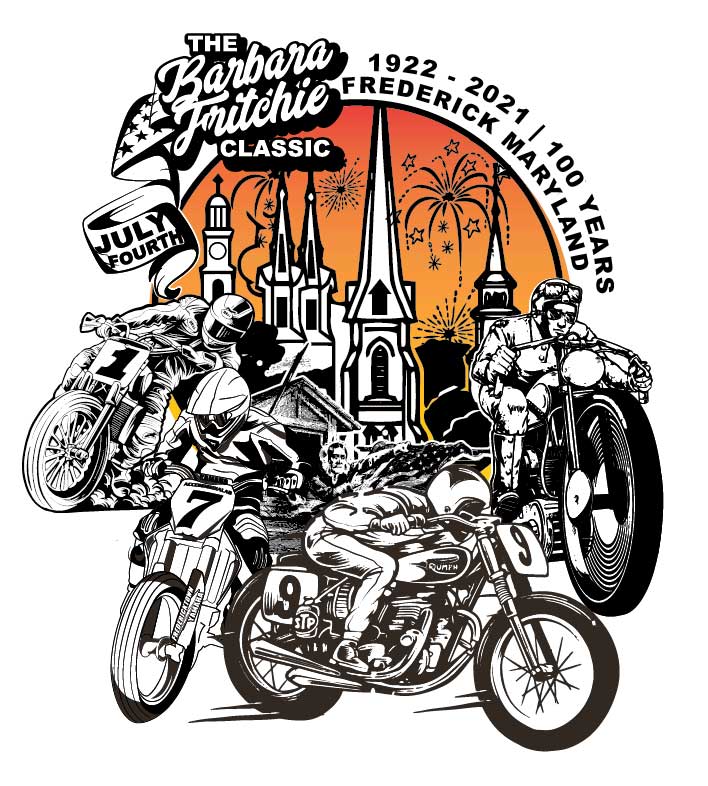
by Mary Grace Keller from https://www.fredericknewspost.com
The 100th Anniversary of Barbara Fritchie Classic
There’s a short list of factors that can prevent the country’s oldest continuous dirt track motorcycle race — the Great Depression, World War II, rain and most recently, COVID-19.
But not this year.
The Barbara Fritchie Classic will return to the Frederick Fairgrounds July 4 after the pandemic led to its cancellation in 2020. This year will mark 100 years of tradition at the location since the series started in 1922, according to race organizer Richard Riley.
“The race is on,” he said.
The event will look a little different from years past. The plan is to limit the grandstands to 1,500 spectators (half capacity), COVID-19 safety protocols will be in place, visitors will notice extra cleaning throughout the event, and hand sanitizer will abound.
Riley isn’t worried about reducing the capacity in the grandstands, since they usually see 1,500 to 1,800 spectators, and many of them stand around the racetrack’s fence.
“It’s just good dusty fun,” Riley said.
New this year, the event will offer a STACYC exhibition for youngsters competing on electric bikes. More details are to come, but Riley said the event will probably be geared toward kids ages 4 to 6.
“The kids got to get out,” he said. “They can’t stay in the house all day.”
He also hopes to display restored vintage racing bikes from the era of the first race.
Riley’s been involved in the race in some way since 1977 and first attended in 1968. For decades of his life, the Fritchie Classic has been synonymous with celebrating Independence Day.
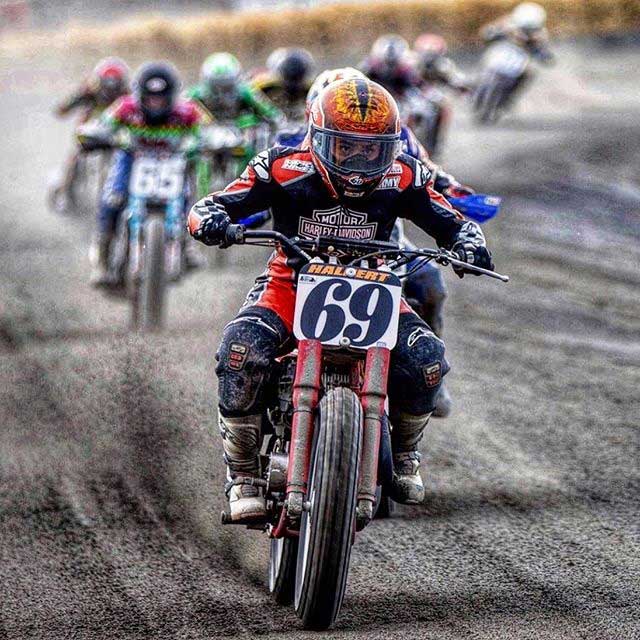
Last Fourth of July, Riley found himself staring at the empty fairgrounds. He nearly cried when he had to cancel the event.
“I just looked in there. Everything was locked down,” he recalled. “It would have been strange for me not to go to the Frederick Fairgrounds on the Fourth of July.”
The decision did not come easily.
“I was forced to make a decision that I don’t regret,” Riley told the News-Post in June 2020. “But it’s not something I wanted to make. It was nothing that I would have told you I would have done six months or longer ago.”
One of the competitors looking forward to kicking the dust up at the fairgrounds is 2018 winner Cory Texter of Lancaster, Pennsylvania.
“[I’m] looking forward to going back,” Texter said.
He won the main event Expert/Pro Twins race at the 97th running of the Barbara Fritchie Classic. His sister, Shayna, is also a past winner but in the 450cc Pro Sport race in 2008.
“Because it’s so technical, I seem to do really well there,” Cory Texter said. “It’s one of the biggest non-national races we do.”
The history of the half-mile track itself is a draw to competitors. Riley said they’ve had racers from all over the U.S. as well as other countries.
“There’s a tremendous amount of tradition,” Riley said. “I promised I’d get it to 100.”
Richard Riley invites those interested in attending the Fritchie Classic to visit barbarafritchieclassic.com for more information and to buy tickets in the future.
Tickets will also be available at Fredericktown Yamaha, which can be reached at 301-663-8333.
A 17-year-old is taking the motorcycle racing world by storm
By Wayfarer |
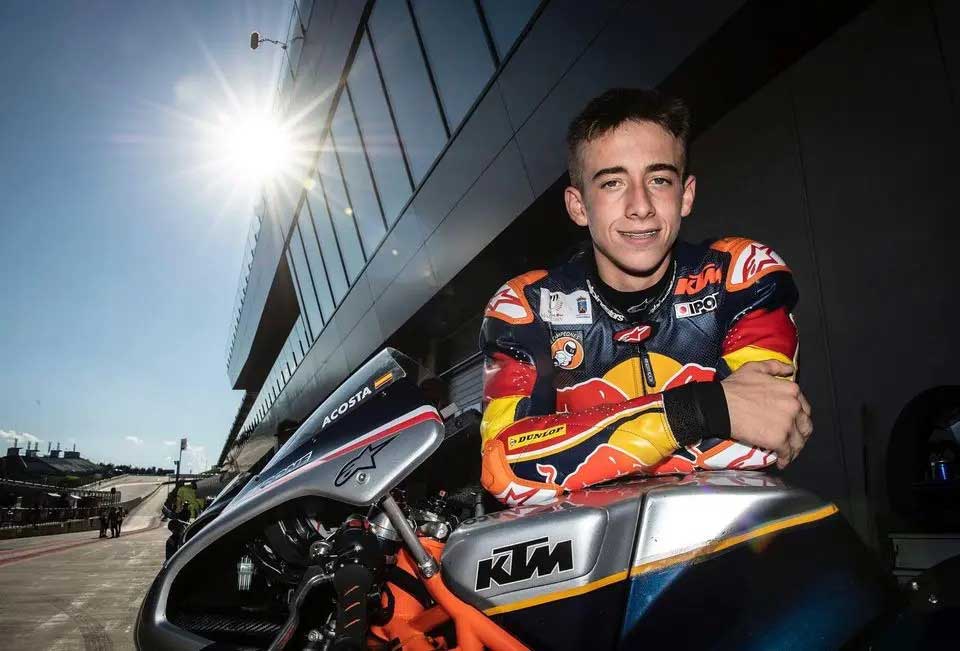
by James Warren from https://www.theolivepress.es
SPAIN has often been called the mecca for motorcycle racing, with world champions being cultivated from the moment they can sit on a bike.
Household names like Marc Marquez, Aleix Espargaro and current champ Joan Mir all started riding and racing while they were at school, making use of Spain’s love of two wheels to develop their talents unhindered.
As these riders fight to earn their latest victories in 2021, they all have one eye on one name that is causing waves in the Moto3 World Championship.
And that name is Pedro Acosta, a young 17-year-old from Mazarron, Murcia.
So far in 2021, the young man has taken three victories and one podium in the first four races, shattering records for the 250cc class and leaving experts to hail him as a ‘future legend’.
But how has this teenager become one of the most exciting prospects since Marc Marquez arrived on the scene back in 2008.
The answer can be found at the Circuito de Cartagena, a race track six kilometres northwest of the popular resort.
The circuit is popular with trackday riders, people who own motorcycles who rent sessions on the track to hone their skills.
Acosta’s father, also Pedro, was one such rider, with a love for American legend Kevin Schwanz, and eager for his son to inherit his love for two wheels.
“Dad had a Suzuki like Schwantz’s and I grew up looking at the photos and videos of him.” said Acosta in an interview with Spanish publication Marca.
Acosta’s father, keen to see his son carry on the mantle, give him a €150 Chinese Motina bike at the age of five, and brought him to track days at the Cartagena circuit to watch his father ride.
“At first he was not interested, spending more time playing rather than watching, but he soon began to become intrigued to what I was doing.” said his father.
Acosta enrolled into a youth development program at the track ran by early mentor Francisco Marmol, a name that would become an integral part in Acosta’s rise to stardom.
“He would always be at the track with his father, and after a few years we enrolled him in our program, like an after-school club for riders.” said Marmol.
“He developed a taste for it very quickly, and grew a strong bond with me, he listened very intently and it became apparent that he had no fear.”
“He was open to experiment and try new things that I suggested. Some people say they can see a natural talent in children this age but it is not true, it is too early. But Acosta was always ready to learn, and enjoyed every moment, and that was the key.”
The son of a modest fisherman and a mother Mercedes, who didn’t care for racing, Acosta, with the help of Marmol and the KSB Federation, entered numerous national championships as soon as he was old enough, and won the Pre Moto3 championship in 2017.
As a result, Acosta entered the Spanish Junior Moto3 category (CEV), finishing 33rd after racing in just five races, but more importantly giving him his first proper taste of 250cc machinery.
His stint in the CEV gave him the confidence to apply for the Red Bull MotoGP Rookies Cup, the official starter class for the MotoGP championship and a place where teams scalp for potential talents.
Acosta made the cut, and in 2019 he began his first foray into international racing.
He impressed, taking three victories and five podiums on the way to a second place finish after 12 races.
In 2020, Acosta remained in the Rookie’s Cup and claimed an unprecedented six straight victories and a further three podiums to take the championship n his second attempt.
His performance got teams talking, and for 2021 Acosta joined the Austrian Red Bull Ajo KTM team on the factory KTM RC250, colours that would propel him into the eyes of the world.
The current crop of riders are already heaping praise on the Spanish youngster, but are concerned that his rapid rise to stardom could be his downfall.
“It is clear that he can become a champion, he has the talent, but he has to surround himself with the right people.” said 2020 champion Joan Mir.
This is a sentiment that is echoed amongst the other riders, with Franco Morbidelli and Marquez all offering words of wisdom to the 17-year-old.
“He must be left alone to enjoy his time on the bike, to concentrate on his development and not be forced to advance to quickly.” said Marquez.
Marquez is referring to rumors that Acosta is already being touted for MotoGP ride, skipping the intermediate Moto2 category altogether, a move that has concerned many.
“Moto2 is a valuable stepping stone, you learn a lot from 675cc racing machinery that you can’t pick up from Moto3, or even training on larger bikes.” said Mir.
“As Pecco (Bagnaia, current Ducati rider) said, two years in each category is sensible, it is important not to rush. It is clear he is something special but he must do what is best for him not what is best for the teams or promotions.”
What Acosta does next year is uncertain, but from humble beginnings he has gained admiration from not only his childhood heroes, but also racing fans across the globe.
Update from Progressive Laconia Motorcycle Week
By Wayfarer |
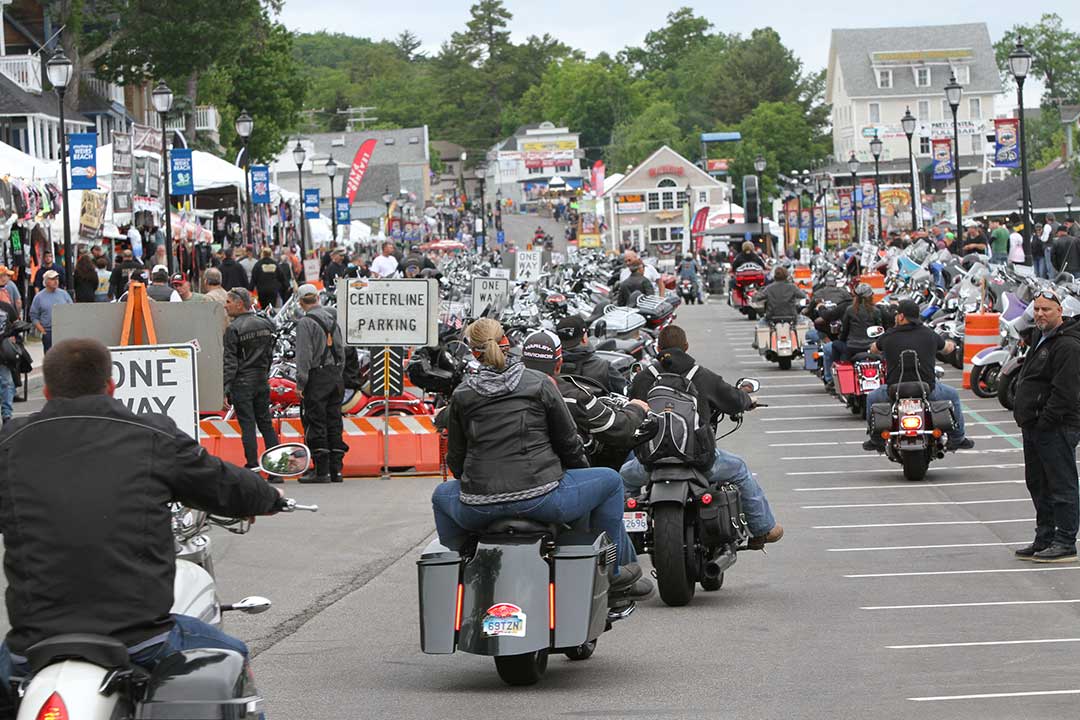
Come Ride in NH – Laconia Motorcycle Week, June 12th-20th, 2021 – New Hampshire – home to America’s Original Riding Rally®
Progressive Laconia Motorcycle Week® returns to the Lakes Region this June 12-20 for its 98th year. Over a quarter of a million riders are expected to attend this year after a pandemic-induced postponement to last year’s rally. The event is host to a full week of music, vendor exhibits, racing and, of course, riding.
Although Motorcycle Week centers around Weirs Beach, you’ll find riders in every corner of the state, from the seacoast to the White Mountains. That’s because New Hampshire’s scenery, fresh air and accessibility are unmatched. Riders can cruise through the mountains, the state’s famed covered bridges, iconic lakes and along the seacoast, all within a matter of hours. Try that anywhere else!
And unlike other events that draw such large crowds, and with that- traffic, residents and businesses embrace this uniquely New Hampshire tradition. By conservative estimates, the week-long event brings over 100 million dollars to the state’s economy each year. Restaurants, hotels, fuel & liquor sales across the state see a huge boost. It is a catalyst for countless tourism dollars, especially helpful because it occurs during the spring season, before the bustle of summer kicks in.
Whether you’re a Motorcycle Week veteran or a first-time attendee, Laconia Motorcycle Week® invites you to experience the thrill of the world’s oldest motorcycle rally®. Come see history in the making as we count down to 100. Come ride in New Hampshire!
Laconia Motorcycle Week® gives great appreciation to all of our sponsors, especially our Presenting Sponsors: Progressive, AMSOIL and Team Motorcycle, as well as the State of New Hampshire for their large financial support of our rally each year.
For more information about visiting the state of NH, check out visitnh.gov.
Laconia – where rallies were invented! https://laconiamcweek.com/
BMW Motorrad campaign for Women’s International Day in Motorcycle
By Wayfarer |
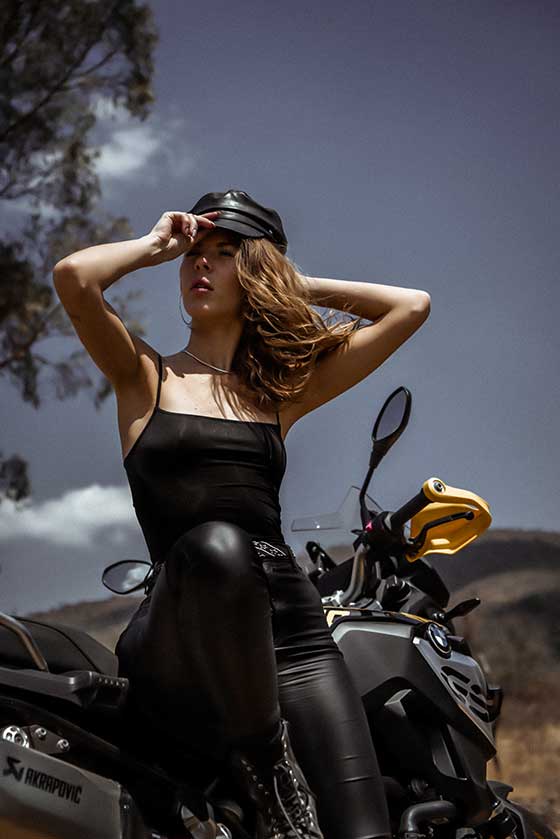
Bia Dantas celebrates Womens International Day in Motorcycle success campaign
BMW MOTORRAD launched campaign starring Bia Dantas among other figures. The purpose was to emphasize the empowerment of women in commemoration of Women’s Day.
My time in the world of motorcycles just started & I couldn’t have a better start… happy to participate in this project, from a brand that I admire and with such outstanding professionals and women” — Bia Dantas
MIAMI, FLORIDA, UNITED STATES, May 10, 2021 — Under the motto: Together we are stronger. Make Life a Ride. On March 8, BMW MOTORRAD launched a campaign starring the Influencer, DJ and Top Model Bia Dantas among other figures. The purpose of the campaign was to emphasize the empowerment of women in the framework of the commemoration of International Women’s Day.
The campaign was recorded in the vicinity of the Teotihuacan pyramids, which allowed the construction of a perfect and unique setting.
Weeks after the campaign launch, we can assure you that the campaign was very successful and had a relevant scope. Consolidating BMW Mexico as the leading motorcycling company and with great proximity to the female consumer.
It should be noted that the message of the campaign focuses on highlighting the path that each personality has had to travel with its challenges and the power of motorcycling to support the development of women in groups and individually. Emphasizing that together or individually with effort and preparation the woman is stronger. Bia Dantas was the perfect influencer for this campaign. Also, the crew had a Balloon Ride next to the Teotihuacan Pyramids that create a perfect environment for team production.
On the other hand, Bia Dantas highlighted that during the filming of the campaign she had her country very present: “I bring my jacket from my dear old Moto Club with the flags of my country and the Brazil-Alagoas State. Always representing ”.
BMW Motorrad Mexico is part of BMW de México S.A de C.V. with address at Av. Javier Barros Sierra 495, 14th floor Cdmx.
Recently Bia Dantas starred on the cover of Glamour Bulgaria with a production dedicated to commemorating the mergers between the different cultures of Brazil. Also, Bia Dantas was cover in Harpers Bazaar a few weeks ago.
Bianca Dantas is an Influencer, DJ and Top Model. Account @biadantasbr. She has collaborated in various campaigns and editorials, highlighting covers of world-renowned titles such as Harpers Bazaar, Vogue Magazine, and Glamor. She currently stands out in the world of music under the name of DJ BiaD @ Biad.oficial. She was born in Brazil and currently lives in Mexico City.
All electric brand separate from the Harley-Davidson brand
By Wayfarer |
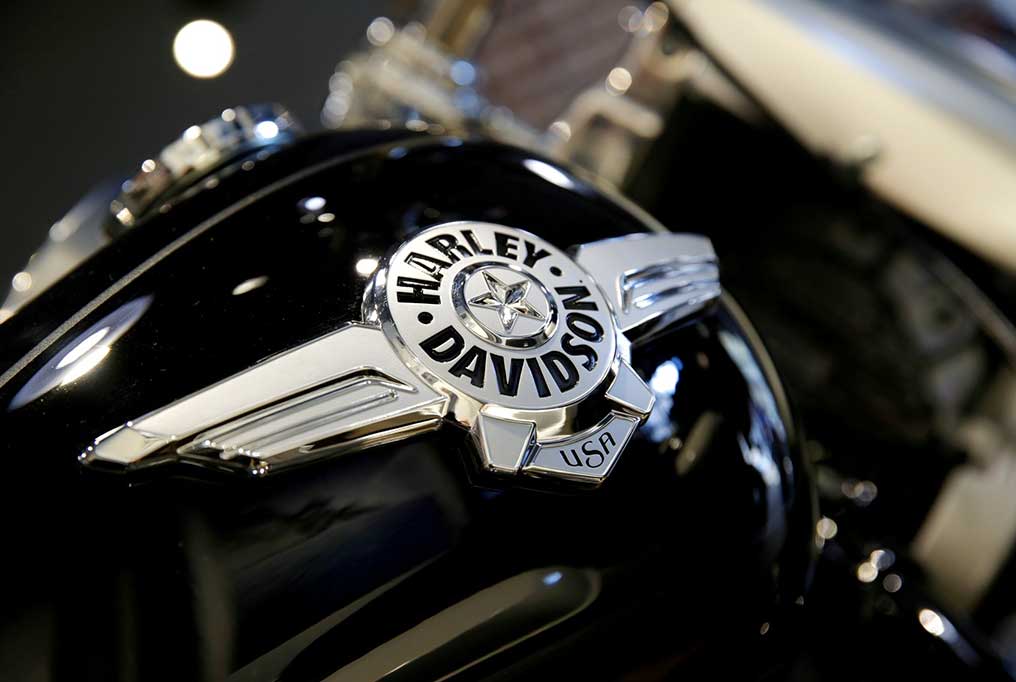
Harley-Davidson launches new electric-only LiveWire brand. Harley-Davidson’s LiveWire is no longer just a model, it’s a whole brand.
The brand’s first dedicated model will debut on July 8.
by Kyle Hyatt from https://www.cnet.com
Pretend you’re Harley-Davidson for a minute. You’re the oldest continually operating American motorcycle manufacturer. You have legions of rabid fans acting as unpaid brand ambassadors. Your name is basically synonymous with motorcycling. Sounds good, right?
Now, as Harley-Davidson, try and do something completely and utterly different than what you’ve done in the past. Now that history is working against you, and those loyal customers think you’ve betrayed the ideals of the brand they love. It’s a real Catch-22. You need to innovate, or you’ll die, but if you innovate, you make your core customers angry, and then you die. While things weren’t actually quite that dire for H-D, it’s definitely been tough.
That’s pretty much what happened when Harley-Davidson launched the LiveWire electric motorcycle a few years ago. Now though, the folks in Milwaukee have decided to try a different route with the whole electric motorcycle thing, and that’s to spin LiveWire off into its own brand, according to an announcement Monday. New brand equals no baggage and that extra freedom to do new things could be just what Harley needs.
“One of the six pillars of The Hardwire Strategy is to lead in electric – by launching LiveWire as an all-electric brand, we are seizing the opportunity to lead and define the market in EV,” Harley-Davidson CEO Jochen Zeitz said in a statement. “With the mission to be the most desirable electric motorcycle brand in the world, LiveWire will pioneer the future of motorcycling, for the pursuit of urban adventure and beyond. LiveWire also plans to innovate and develop technology that will be applicable to Harley-Davidson electric motorcycles in the future.”
The LiveWire brand will have its own models and its network of showrooms, the first of which will be in California. It will be separate from Harley-Davidson in most respects, but it will share technology with the mothership as well as its manufacturing footprint and supply chain.
The first new model from the LiveWire brand is set to debut on July 8, 2021.
Harley-Davidson launches all-electric motorcycle brand ‘LiveWire’
by Reuters from https://www.saltwire.com
Harley-Davidson Inc on Monday launched an all-electric motorcycle brand “LiveWire,” the latest effort by the company to ramp up bets on the rapidly growing electric-vehicle market.
Named after Harley’s first electric motorbike, which was unveiled in 2019, the “LiveWire” division is slated to launch its first branded motorcycle in July.
The company had said in February it would create a separate electric vehicle-focused division, as it aims to attract the next generation of younger and more environmentally conscious riders.
“We are seizing the opportunity to lead and define the market in EV,” Chief Executive Officer Jochen Zeitz said in a statement on Monday.
“LiveWire also plans to innovate and develop technology that will be applicable to Harley-Davidson electric motorcycles in the future.”
Harley-Davidson Launches LiveWire as independent Electric Motorcycle Brand
By Wayfarer |
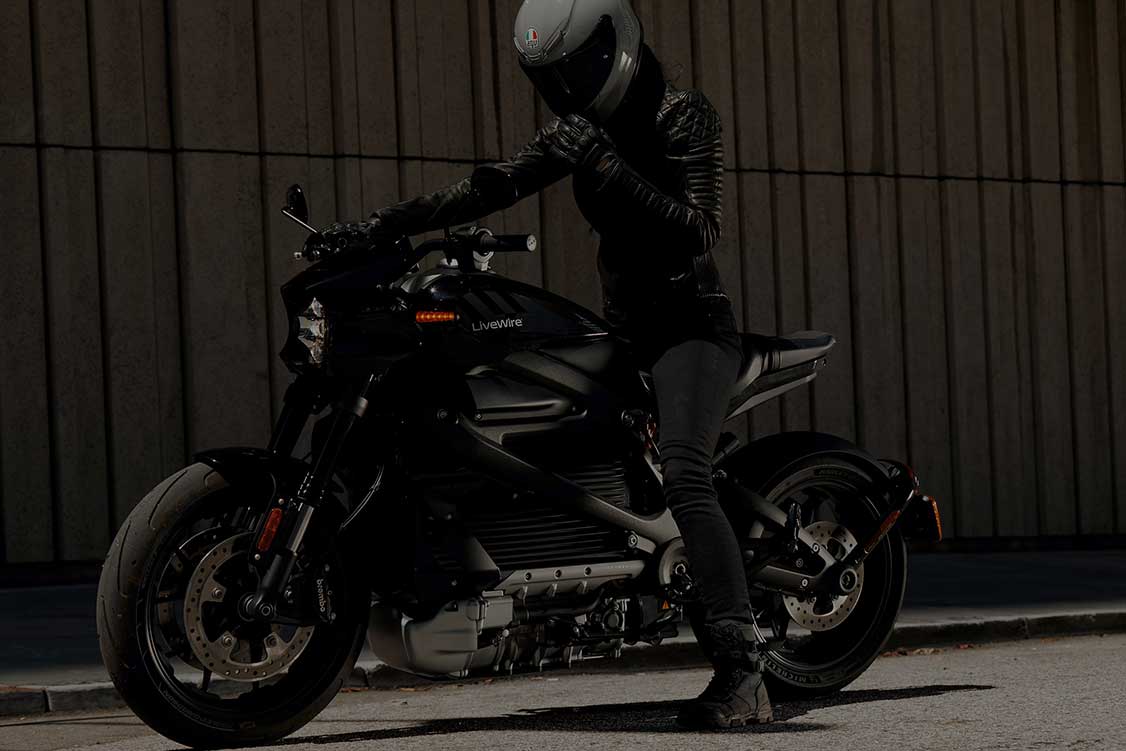
Harley-Davidson Launches LiveWire, the independent Electric Motorcycle Brand (www.livewire.com)
MILWAUKEE (May 10, 2021) – Harley-Davidson, Inc. (“Harley-Davidson”) (NYSE: HOG) today announces the launch of LiveWire as an all-electric motorcycle brand.
LiveWire is more than a motorcycle. LiveWire plans to redefine electric, delivering the best experience for the urban rider, with personality and soul. LiveWire creates a unique connection between rider and vehicle. Today, the next chapter in the LiveWire journey begins.
Jochen Zeitz, chairman, president and CEO of Harley-Davidson:
“One of the six pillars of The Hardwire Strategy is to lead in electric – by launching LiveWire as an all-electric brand, we are seizing the opportunity to lead and define the market in EV. With the mission to be the most desirable electric motorcycle brand in the world, LiveWire will pioneer the future of motorcycling, for the pursuit of urban adventure and beyond. LiveWire also plans to innovate and develop technology that will be applicable to Harley-Davidson electric motorcycles in the future.”
The first LiveWire branded motorcycle is scheduled to launch on July 8, 2021 and to premiere at the International Motorcycle Show on July 9, 2021. For more information and updates, register at livewire.com.
Unique lineage: LiveWire draws on its DNA as an agile disruptor from the lineage of Harley-Davidson, capitalizing on a decade of learnings in the EV sector and the heritage of the most desirable motorcycle brand in the world.
Motorcycles + beyond: with an initial focus on the urban market, LiveWire will pioneer the electric motorcycle space, and beyond.
Virtual HQ: innovating by design and attracting industry-leading talent, LiveWire will be headquartered virtually, with initial hubs in Silicon Valley, CA (LiveWire Labs) and Milwaukee, WI.
Marketplace: from launch, LiveWire will work with participating dealers from the Harley-Davidson network as an independent brand. An innovative go-to-market model will blend digital and physical retail formats, tailoring the experience to the local market and allowing customers to discover LiveWire on their own terms.
Dedicated showroom: seizing the opportunity to lead in EV and innovating across the customer journey, LiveWire will operate dedicated EV showrooms in select locations, starting in California. Here customers will be able to experience the LiveWire brand in an immersive and innovative way.
Technology focus: with a dedicated focus on EV, LiveWire plans to develop the technology of the future and to invest in the capabilities needed to lead the transformation of motorcycling. LiveWire expects to benefit from Harley-Davidson’s engineering expertise, manufacturing footprint, supply chain infrastructure, and global logistics capabilities.
Technology sharing: Harley-Davidson and LiveWire intend to cooperate and share their technological advancements to ensure an industry leading application in their respective core segments.
FANDANGO 2021
By Bandit |

A couple of years ago the growing membership of the Cherokee Chapter of the AMCA (Antique Motorcycle Club of America) in central Texas made a monumental decision. The antique motorcycle group wanted to establish a major antique motorcycle event closer to the center of the country. Davenport, Iowa, Daytona, Florida and Wauseon, Ohio were like a thousand miles away.


The decision was made to institute a serious antique motorcycle event in Texas, not historically a motorcycle state, but don’t tell the Bandidos that. They looked hard at the Dallas area for proximity, but ultimately the town of Fredericksburg. It shined for several reasons, located just 70 miles from Austin and San Antonio in an area blessed with beautiful open roads and terrific destinations such as Lukenbock, Texas where Willie and the boys play (just six miles away).


Here’s where they could have stumbled into a briar patch of thorns. Fredericksburg is of German heritage, and celebrates Pioneering, ranching, rodeos, oil, cattle, the old west but not motorcycles. The town thrived on tourism and contained breweries, distilleries, and wineries. So persuasive Greg McFarland the president of the Cherokee Chapter of the AMCA met with the city and the fairgrounds officials and miraculously they were all for this event.


“The fairgrounds are larger than the Davenport location and a bit smaller than Wauseon, Ohio fairgrounds,” said Steve Klein, of the Gillespie County Fairgrounds, the first facility to host a fair in Texas in 1881. Officially established in 1888, 133 years ago, they are the oldest continuously operating Fairgrounds in Texas. “It sported 133 years of horse racing until three years ago. Now we race motorcycles.”


Greg McFarland, the current president of the chapter came up with the name Fandango and it stuck. Fandango (noun) means, “a foolish or useless act or thing” Tomfoolery. Greg and Steve developed a successful formula for the event, much like the infamous Smoke-Out: Action all the time and something for everyone.


The Fandango fairgrounds rocked with motorcycle action, interactive play, education, races and shows. The first year 2019, a national AMCA antique motorcycle ride ended at the Fairgrounds. This year Oliver Peck of Inkmasters TV series hosted the Chopper Coral with over 100 choppers on display along with Chopper related vendors and a bandstand.


The town stepped up this year after the Covid canceled 2020 and built an official ½ mile flat track. The old horse track contained over 6 inches of surface sand, which had to be moved to form a rideable track.


Cycle Source Magazine sponsored an indoor show. Over 116 motorcycles were on display of ever vintage and make including: American, Italian, German, Asian, Vincents, H-D, Indian, Excelsior Henderson, BMW, Honda, Kawasaki, Suzuki, street bikes, vintage, trails, enduro and motocross were represented.


The RV park at the facility was packed and brothers and sisters formed tents with their highbar choppers and slept on the grounds. “Tent camping looked like Woodstock with choppers, VW vans, and vintage vans with shag carpet interiors,” said Steve. “Young bikers slept on Indian blankets next to their choppers. Young ladies in halter tops and striped bell bottoms were everywhere. It was a throwback to the ‘60s.”

One of the major Fandango goals was to make it new- enthusiast friendly. “We wanted to develop a larger, younger membership in their 20s and 30s. Our existing membership average age is 62,” said Steve. They were proud to host over 600 spectators who were from their teens to early 30s.



“They dug the choppers and young enthusiasts couldn’t get enough of their swap meet and mini-bike races.” After being locked down for 18 months and with no sources for vintage parts the demand was high for action and resources.


They hosted 200 Vintage vendors who bought 262 vending spots. “No modern shit or non-motorcycle shit,” Steve pointed out. All the existing vendors have already signed on for 2022. “This is an old-fashioned motorcycle event that is low key and enjoyable.”

Attendance surpassed 5,000 and the action never stopped with chopper dirt drags and mini-bike races, contests and pinstriping demonstrations. The fairground grandstands held 1,700 folks and the Chopper Drags drew a crowd. The XTREME Flat Track National Organization organized the flat track race to be the second of the national circuit after Daytona Bike Week.



“If you want to dodge the crowd for a minute,” Steve added. “The best riding in the entire state of Texas is right here.” Next year they plan for more tent camping with showers, better signage, improved trash services, etc. “We want everyone to have a great time all the time.”


.jpg)


Harley-Davidson FL 1946 Sells for 473 Times Its Original MSRP
By Wayfarer |
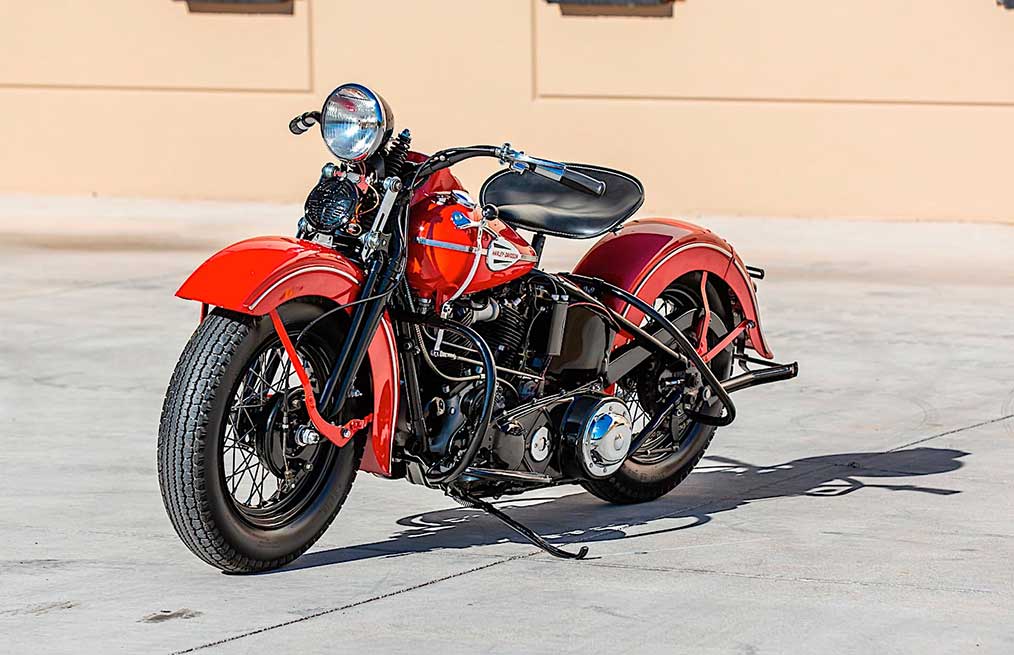
by Daniel Patrascu from https://www.autoevolution.com
Born at a time when World War II was raging all across the world, the FL line of motorcycles turned out to be a hit in the Harley-Davidson portfolio. Little did the bike maker know however that many decades after its introduction, this line of Knuckleheads will be worth many times over their original money.
The FL you’re looking at, sporting a bit more chrome than what the bike maker offered back then, comes from the year immediately after the end of the war. It looks so shiny and new thanks to a restoration process it went through about a quarter of a century ago. A restoration process that also helped significantly increase its value.
You see, back when it was made alongside close to 4,000 others of its kind, the two-wheeler had an MSRP of just $465. Adjusted for inflation, that would be around $6,200 in today’s money. Still a very, very long way from the sum it just sold for last week.
The bike was listed on the massive lot that went under the hammer during the huge Mecum motorcycle auction in Las Vegas. This particular FL shares the second position on the podium for most expensive bikes sold there with an E model from 1943, behind the champion of the event, the $297,000 Strap Tank.
$220,000 is how much someone paid for the FL, which would be 473 times more than its original price back in 1946, or 35 times more if we do the math with the inflation-adjusted amount.
Although we’re not specifically informed of this, we reckon the 74 cubic inch engine linked to a four speed transmission is still in working order, but do not expect this motorcycle to take to the roads anytime soon. That’s because there are only two reasons people generally pay this much for a bike this old: included it in a collection, or waiting for its value to increase some more so it could be sold for a profit.
Indian Motorcycle from 1903 sold for $143K
By Wayfarer |
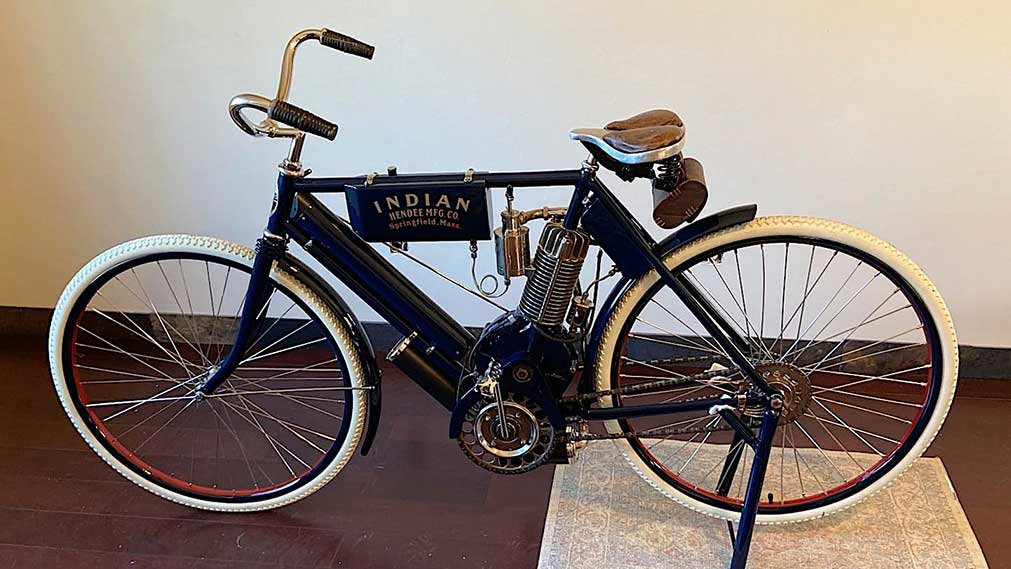
by Daniel Patrascu from https://www.autoevolution.com
It’s been a hell of a ride for those taking part last weekend in the massive motorcycle auction in Las Vegas. The top highest-selling two-wheelers, for instance, were responsible for getting close to two million dollars combined, in a bidding frenzy that seemed to have had no limit.
Out of this select team of ten motorcycles, eight of them were Harley-Davidsons, including the champion when it comes to money earned, the $297,000 Strap Tank. The other two were a Vincent Black Shadow from 1953 (sold for $165,000), and this here 1903 Indian that went for $143,000.
For all intents and purposes, the Indian is the oldest in this select lot. What’s more important is that for the first 62 years of its life, from 1903 to 1965, it was owned by the same guy, a California motorcycle racer by the name Gus Cheleini.
Looking probably just as good as it did 118 years ago when it was made, the motorcycle comes in a dark shade of blue and it is equipped with a tiny 13ci engine and an atmospheric valve that is still working, hinting according to auction house Mecum, which handled the sale of the two-wheeler, that the bike could be “started and ridden.”
Part of a select and limited number of bikes made under the Indian name that year, it still wears the first name of the company, Hendee Manufacturing, and features the large gas tank on the rear fender that earned it and its breed the nickname Camelback.
Since the death of its first owner, the Indian changed hands a few more times, and was featured in The Classic MotorCycle in 1988, but mostly spent its time out of sight. It’s unclear what the future holds for it, as we are not told who purchased it, but chances are we’ll get to see it again at a similar auction in the not-so-distant future.

